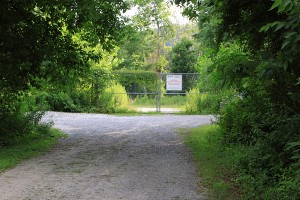EPA Crown Vantage Landfill Superund Site Cleanup Plan Proposed
Crown Vantage landfill – scar on Delaware River
[Update below]
I attended and spoke at the EPA public hearing last night in Milford, on the proposed cleanup plan for the Crown Vantage Landfill Superfund site.
The Crown Vantage site is on the banks of the Delaware River, just south of another industrial Superfund site known as Curtis Specialty Papers, and less than a half mile north of the old Riegel Paper Company landfill. (Google maps).
Crown Vantage, Curtis Specialty Paper, and the Riegel Landfill are all geographically close, as well as historically operationally inter-related with each other.
According to the EPA site history, from the 1930’s to the 1970’s, the Crown Vantage Landfill received industrial waste from the nearby Curtis Specialty Paper Company and 4 other nearby Riegel Paper Company Mills.
The Riegel Paper Co. Landfill is known to have received the same industrial wastes as the Crown Vantage Landfill, yet there is virtually no attention paid to the proper closure and cleanup of the Riegel paper Co. site by the NJ DEP.
The Riegel Paper Co. Landfill is the site where NJ DEP notoriously claimed that leachate discharging into the River was “natural“. DEP subsequently corrected that error and conducted sampling (I have not reviewed the data and don’t recall media reports on the results of that effort).
One [Crown Vantage] site is a federal Superfund, the other site – same wastes disposed, same sensitive riverbank and adjacent D&R Canal Park location, and actively discharging leachate to the Delaware River – essentially nothing, not even State NJ DEP landfill closure enforcement.
I asked EPA people about this and they passed the buck to the NJ DEP.
Anyway, lets get back to Crown Vantage.
As a result of flooding and erosion, contaminants from chemicals disposed and drums buried on site have migrated off site and polluted the Delaware River, river sediments, and terrestrial and aquatic ecosystems.

Crown Vantage Superfund site, just feet off the D&R Canal path (view from standing on the path)
The site is located between the Delaware River and the extremely popular D&R Canal State Park, and thus poses additional risks to recreational hikers, bikers, birders, hunters, and fishermen. Of course, given its proximity to the Park and secluded riverfront, the site is a magnet for trespassers (ATV’s, kids, stealth campers, ramblers, beer parties, etc).
This sensitive situation prompted EPA to force the Responsible Parties (Georgia-Pacific and International Paper Company) to excavate and remove over 2,000 drums, fence and post warning signs at the site, and install a wall to prevent further flooding erosion. Those measures removed the immediate threats and stabilized the site, during which time, EPA required that the RP conduct a full remedial investigation and a feasibility study, outlining alternative final cleanup plans for public review.
The Superfund law establishes what is know as a “preference for permanent remedies”. The law mandates that cleanups must use permanent solutions to the maximum extent practicable (see discussion at page 7).
Yet, despite the statutory preference and mandate for a permanent cleanup (e.g. removal of all buried drums, contaminated soil, et al), a permanent remedy was not even an alternative that EPA proposed for public comment.
EPA proposed 2 alternatives: no action and their preferred alternative, which is stabilization of the site by existing forested cover, a previously constructed flood wall, and deed restrictions to prohibit future development.
Some choice! Do nothing or do it our way.
In this case, EPA says the trees on the site basically comprise a cap and containment system. EPA usually requires an engineered cap, so I never heard of that before and asked EPA to justify that approach.
I was pleased that the Express-Times reporter picked up on that important point (see: EPA unveils plans for Crown Vantage Landfill Superfund site in Milford)
EPA Remedial Project Manager Alison Hess said the site presents no imminent risk to public health, and the proposed plan will ensure it stays that way.
“The remaining wastes are considered low-level threat wastes,” she said. “Containment is appropriate for those wastes. …
Bill Wolfe, of West Amwell Township, said he feels capping the site is more appropriate for larger landfills and that the EPA should have considered further removing the remaining pollutants.
“Your first alternative should be to dig it up and take it away, and if it’s found not be feasible, then you consider capping and containing,” he said.
In addition to concerns about failure to propose a permanent remedy for public comment, I noted the following concerns:
1) Like most old landfills, there is little or no reliable data on historical waste disposal. So, EPA really doesn’t know exactly what, where, how much, when, and what kinds of chemical wastes were disposed there. Additionally, methods of investigation (review of historical aerial photos, geophysical technique to probe subsurface looking for buried drums, dug test pits, borings, etc) are inherently uncertain.
These uncertainties argue in favor of complete removal, yet EPA seems confident that they have removed the “principal threat” and are leaving only small volumes of low risk materials on site. I asked EPA to reconsider, and at a minimum better document and justify these conclusions.
2) despite off site sediment samples that exceeded the NJ DEP ecological risk screening criteria, EPA did not fully investigate potential impacts to fish and aquatic ecosystems. EPA did look at birds and mammals and found no significant risks.
Given documented off site release and sediment data, I asked EPA to conduct an evaluation of fish and aquatic life impacts and work with federal partners to look into seeking compensation and/or restoration for natural resource damage injuries, including loss or impairment of recreational uses of the River and D&R Canal Park.
3) The site was abandoned in Bankruptcy proceedings, so there is no legal owner at this time.
I therefore questioned EPA’s proposed plan to allow the Responsible Parties to voluntarily negotiate a deed restriction to prohibit future use of the site. Instead of reliance on voluntary measures, I strongly urged EPA to issue a unilateral Order to the Responsible parties to set specific deed conditions and a deadline for this deed to be finalized.
4) I questioned the wisdom of the remedial objective, which is limited to exposure control (not permanent cleanup and elimination of the risk).
A deed restriction can only prevent some (but not all) future uses of the site itself, and EPA is unable to control future land use adjacent to the site.
NJ has brownfield redevelopment policies that actively provide incentives to redevelop contaminated sites. So no risk from future development can not be assumed. These future land use changes could change the exposure and risk assumptions and conditions upon which the EPA cleanup decisions are based. These uncontrollable future conditions argue in favor of a permanent remedy as the best and only approach to assure long term protectiveness of the cleanup.
5) There is a small area of the site (0.25 acre) where lead levels exceed NJ soil screening levels. I urged that these soils be excavated and removed, instead of being allowed to be left in place on site, as proposed by EPA. Long run, they will migrate off site and further harm the sensitive local envrionment.
6) I agreed with other residents who asked why insurance companies have not be involved in funding and questioned how EPA would finance and guarantee the long term monitoring and maintenance of the site. There is currently no enforceable agreement on these issues.
EPA responded to these questions by saying that those key issues would be the subject of a future EPA negotiations with RP’s on implementing the selected cleanup option.
I urged EPA not to rely on voluntary negotiations but instead issue a unilateral enforcement order.
Very few members of the public realize, despite a multi-year remedial investigation and numerous informal EPA meetings on the site (which can lull the public into a stupor and winnow out involvement over the years), that there is only one legally mandated official on the record public hearing where public comment is meaningful and can actually have an impact on EPA cleanup decisions. That time is now. The public comment period closes on July 30, 2011 (see this for how to comment).
[Update #2 – 1/31/12 – Well, today we read that a lot of water has gone under the bridge since July! Always great to learn about stuff from the newspaper! (snark!)
In September, EPA and DEP both approved the ROD.
The EPA response blows off all my comments.
And worse, it looks like EPA still has not entered into the ACO for deed restrictions, long term OM&M, cost recovery et al as promised.
And EPA was supposed to have been providing email reports and updates since July! Despite having made that commitment to do so more than once at the July hearing (see the transcript), EPA failed to do so.
Since I was the most knowledgeable and critical commenter at the July public hearing, I spoke with EPA coordinator Pat Seppi after the hearing, and was quoted in the newspaper sort the next day, there is NO way that EPA failure to keep me in the loop was an accident.]
Update 1: This could be why the DEP is not interested in the leachate flowing into the Delaware River from the Riegel Paper Co. landfill:
Approximately six years after Crown purchased the landfill, it filed for bankruptcy protection in the Northern District of California. As part of those bankruptcy proceedings, it filed a motion under 11 U.S.C.A. § 554 to abandon its interest in this landfill, as well as several others that it owned and operated. The DEP objected to this abandonment because of the potential risks to the environment posed by abandoned landfills. To secure the DEP’s agreement to this motion, Crown agreed to pay $1 million to the DEP to be used “to investigate, close, clean-up, or otherwise remediate any environmental condition on any and all property” of Crown in New Jersey. Based upon this payment, the DEP withdrew its objection to the motion, and the bankruptcy court entered an order on March 2, 2001, authorizing the abandonment of this property. The order entered by the bankruptcy court simply referred to abandoning the property and did not mention the 1991 agreement that structured the manner in which the landfill was to operate, nor did it convey title to the underlying land.
Following entry of that order, the DEP used a majority of the funds from Crown to close up another of Crown’s landfills that it considered to require immediate attention. The DEP did no more with the Warren Glen landfill than to periodically visit it and to mow the grass to keep it from becoming overgrown. –
And how’s this for DEP’s ability to monitor its permits and know what the hell is going on – sound like there was illegal leachate discharge to the Musconetcong River:
FiberMark eventually determined, however, in or around November 2005 that it was no longer economically viable to operate the paper mill and began to explore shutting it down and disposing of it and its equipment. Closing the mill of necessity involved closing the treatment lagoons into which leachate from the landfill was continuing to flow.FiberMark did not immediately contact the DEP about its plans, and the DEP learned of them through newspaper reports in early 2006 and began the process, internally, of considering how to proceed. In April 2006, the DEP hired a consulting team formed by The Louis Berger Group, Inc. and Sadat Associates, Inc. (“Berger/Sadat”) to investigate conditions at the Warren Glen landfill, with a particular focus on the potential for erosion, the condition of the landfill’s cap, which appeared to contain cracks, and leachate from the landfill. – end update
